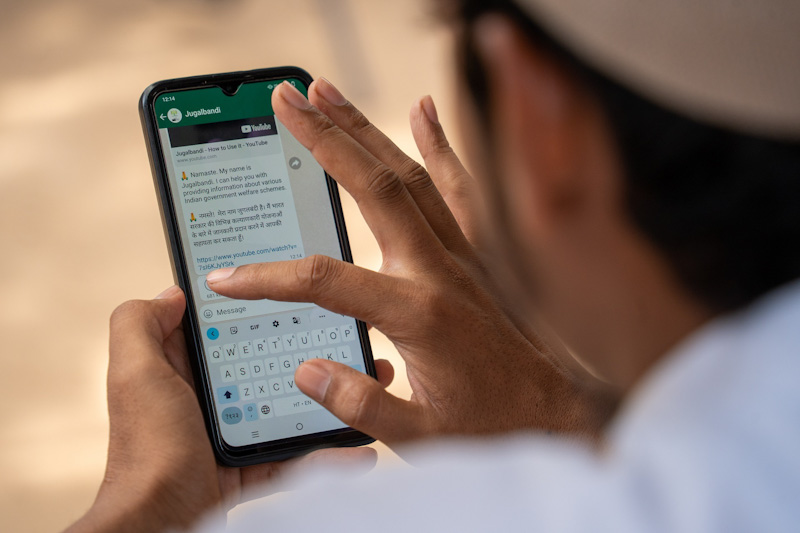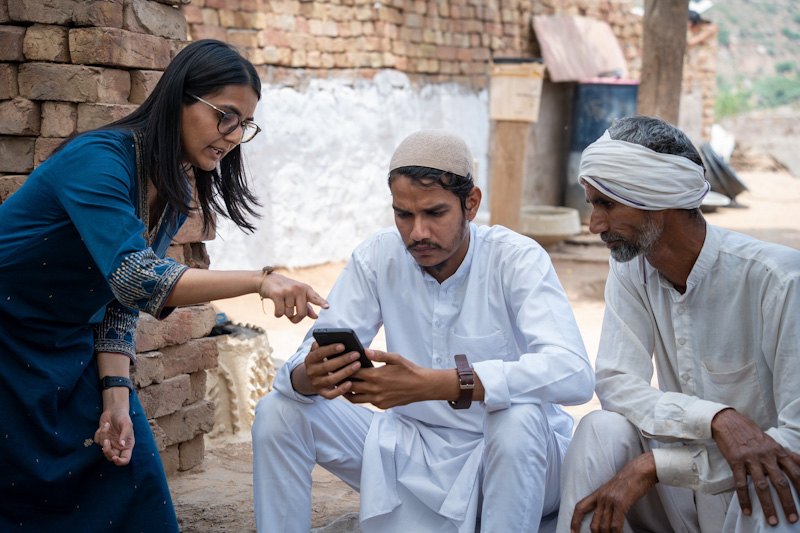Could generative AI help break down language barriers plaguing the Indian justice system?

A farmer uses the Jugalbandi chatbot to find information on government aid. (Photo by Probohadh Singh for Microsoft)
Updated: Kishore Kommi, a police officer and a former data scientist in Andhra Pradesh, a state in the southern coastal region of India, faced a stumbling block as he developed a mobile assistant to help women and children report online harassment. He wanted to create a chatbot to help speakers of Telugu, the state’s official language and the country’s fourth most common.
To overcome the language barriers in a region where the official language the courts use is English, Kommi is making use of Jugalbandi, an open-source multilingual chatbot using generative artificial intelligence.
A Microsoft-backed research group recently rolled it out in India to help the nation’s poorest people get information on government aid, and workers and victims of domestic violence understand their rights. Developers can integrate the chatbot into WhatsApp, Telegram or their own applications.
Even though Kommi is training his chatbot on an English dataset, Jugalbandi allows users to ask a question in their language on WhatsApp and Telegram, either through text or speech, and the assistant can respond in their native language. Although he eventually plans to test the bot with members of the public, he says the assistant is currently being used by police officers, so they can query the bot about cybercrimes, child sexual abuse and sexual assault to assist victims.
“It is giving me the power to remove the dependency on English to leverage the potential of generative AI,” Kommi says. “I need not create the training data in Telugu. I can create all my text and documentation in English. But still, I can get the response in Telugu.”
Jugalbandi borrows its name from a performance of Indian classical music in which two musicians riff off each other. The platform can translate English into 10 languages, including Bangla, Punjabi and Hindi. And with more languages that will come this year, its makers hope that it can address the chronic access-to-justice issues in India, where illiteracy and language and technology barriers prevent people from pursuing their legal rights.
“You can imagine every citizen who cannot read and write suddenly being able to access information in a way that makes sense to them,” says Supriya Sankaran of Jugalbandi’s text-to-speech capabilities, adding that corruption and a lack of awareness about what rights are available are some of the other barriers standing in the way.
“There’s a possibility of us transforming the experience of what accessing legal information looks like,” says Sankaran, a co-founder of Agami, one of the nonprofits supporting the platform.
Although India officially recognizes 22 languages under its constitution, the 2011 census of India recorded that 121 other languages in everyday use and hundreds of other languages and dialects are spoken in the country of 1.4 billion people. In addition, the official language of the Indian Supreme Court is English, even though only about 11% of Indians speak the language. Hindi, spoken by about 57%, is authorized in the high courts of only four states.
About 16% of Indians live in poverty, according to the Global Multidimensional Poverty Index 2022 report by the Oxford Poverty and Human Development Initiative and the United Nations Development Programme. A 2014 report by the United Nations Educational, Scientific and Cultural Organization found that 287 million Indians could not read or write.
By some measures, 80% of the population cannot get a lawyer, and attending court is too expensive for many citizens. According to a 2016 survey on access to justice by Indian think tank Daksh, only 90 respondents, or about 1%, of the 9,329 interviewed had a court-appointed lawyer in civil cases and just 132 in criminal cases.
Then there are tech barriers. Oxfam India’s India Inequality Report 2022: Digital Divide found that in rural parts of the country, “internet availability is either intermittent, poor or nonexistent.” The report suggests that 31% of the rural population had internet, compared to 67% of the urban population. Additionally, the study found while there were 1.2 billion mobile subscribers in 2021, 40% of them did not have smartphones.
Even so, Jugalbandi’s makers want to take advantage of the 500 million people who use WhatsApp in the country, according to Business Insider India. The chatbot combines Indian language models developed by the government-backed research lab AI4Bharat, with ChatGPT, and Microsoft’s Azure OpenAI service.
When a user sends a text or an audio message, an AI4Bharat speech-recognition model transcribes the message into text, and another model translates it into English, according to Microsoft. Based on the person’s query, the bot translates an answer into their preferred language, and AI4Bharat’s text-to-speech model responds with a text and an audio message.
 Lawyer Smita Gupta of OpenNyAI talks about uses for the Jugalbandi app with two farmers. (Photo by Probohadh Singh for Microsoft)
Lawyer Smita Gupta of OpenNyAI talks about uses for the Jugalbandi app with two farmers. (Photo by Probohadh Singh for Microsoft)
Lawyer Smita Gupta works for Agami and OpenNyAI, a nonprofit group that worked on the platform and has a mission to use AI to narrow the justice gap.
There is a distrust of written information in rural areas of the country, Gupta says.
Villages are “media dark,” often lacking television, radio and newspapers, according to Aaditeshwar Seth, a computational science professor and co-founder of the technology company Gram Vaani, in a video on the Microsoft website.
“Every day more than 7 billion voice messages are being sent on WhatsApp,” says Gupta of the app’s global popularity. “Being able to have a conversation in your language and then also being able to trust that information is a giant leap.”
Gupta points to other potential use cases. Judges at the High Court of Karnataka in the city of Bengaluru, India, are looking into piloting the platform in a web-based app called Judges Intelligent Virtual Assistant. According to Gupta, the app would allow them to look up relevant laws during live court proceedings.
If the platform is more widely adopted, it could speed up hearings and cut into case backlogs, according to Gupta, because in India, most courts rely on textbooks to look up sections and laws, slowing down proceedings. With Jugalbandi integration, judges could get answers in seconds, rather than minutes, she says.
Progress vs. privacy
This year, the U.S. government announced several initiatives to regulate AI, and last March, Italy became the first Western country to temporarily ban ChatGPT. But according to TechCrunch, the Indian government’s Ministry of Electronics and Information Technology said last April it was not planning to introduce legislation to regulate the growth of AI.
In August, however, the Indian government passed the Digital Personal Data Protection Bill. The new law does not specifically cover AI but will address some of the privacy concerns that go hand in hand with the tech, according to Jibu Elias, a New Delhi-based AI ethics and governance expert and a responsible computing fellow with Mozilla, a global nonprofit.
While Jugalbandi’s makers are hopeful that it can help some of the country’s poorest and most in need, AI experts have raised concerns about the security and privacy of generative AI chatbots. Moreover, marginalized groups are more vulnerable to security and privacy breaches. But according to Gupta, Jugalbandi does not retain personal identifiers, phone numbers or location data after 24 hours, and the tool includes a filter that recognizes personally identifiable information, so it is not shared with large language models.
“These systems aren’t always bulletproof, and so as more and more methods of safeguarding user data emerge, we’re keen to evolve the platform [so it is more secure],” Gupta says.
In India, Elias says there is a danger that people who are not “digitally literate” could get tripped up by apps that mine or steal their data.
“My concern is that they will be vulnerable if we fail to educate them to differentiate between the good tools like Jugalbandi and other tools built for manipulating them or scamming them,” Elias says.
Gupta says the research group is taking a piecemeal approach and does not envision the platform being so ubiquitous that people across the country can get easy answers to legal questions. Given the diversity of India’s population and the research groups’ limitations in scaling solutions, she does not think that’s likely.
Sachin Malhan, a co-founder of participating nonprofit Agami, is still confident that the platform could “eat away at the access-to-justice gap.”
“We’re hoping it forms an ecosystem, where legal information becomes available at your fingertips through a wide range of state [and] private providers,” Malhan says.
He says there is potential for the platform to spread to developers beyond India, so other countries can address language barriers in their justice systems. In the United States, for example, there are more than 40 million native Spanish speakers.
“We’ve been surprised by the interest that has come from other places, especially in the global south. We’re realizing that language and voice-to-voice [are] a big thing everywhere. When you look at the access problem, which is a much bigger problem globally, then you realize you need a wider suite of tools,” Malhan says.
Updated Jan. 29 at 4:30 p.m. to clarify a quote from Smita Gupta of OpenNyAI.
Write a letter to the editor, share a story tip or update, or report an error.



